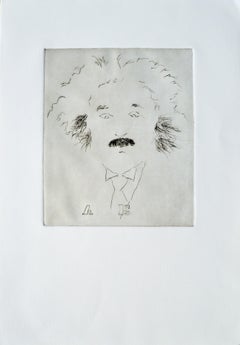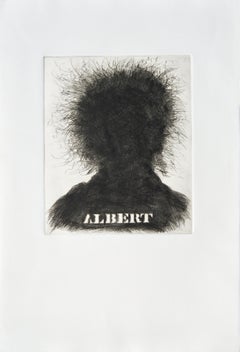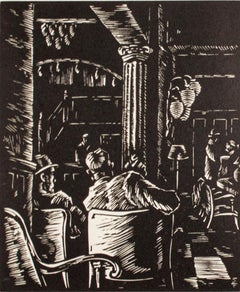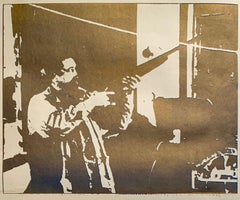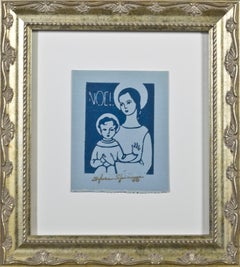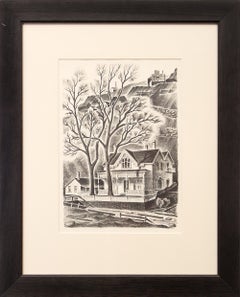American Modern Figurative Prints
to
180
397
136
127
101
58
Overall Width
to
Overall Height
to
15,621
8,190
2,653
2,427
2,254
1,052
1,014
725
672
420
322
112
93
39
74
15
14
14
9
9
785
28
3
18
46
111
97
68
75
77
49
28
515
279
20
483
231
183
182
126
117
109
90
83
73
69
59
55
43
42
36
34
32
28
27
296
203
140
98
78
98
33
789
31
Style: American Modern
"A E" Albert Einstein Portrait #7
Located in Soquel, CA
Albert Einstein portrait, "A E", a black and white collotype print by Lilya Vorobey (American, 21st C). Unsigned. From a collection of her works. On mat board. Image, 9.75"H x 7.75"W...
Category
1980s American Modern Figurative Prints
Materials
Watercolor, Etching
$639 Sale Price
20% Off
"Albert", Albert Einstein Portrait Silhouette
Located in Soquel, CA
Albert Einstein silhouetted portrait, a collotype print, watercolor by Lilya Vorobey (American, 21st C). Unsigned. From a collection of her works. Image, 9.75"H x 5.88"W. Full Sheet...
Category
1980s American Modern Figurative Prints
Materials
Watercolor, Color, Etching
$639 Sale Price
20% Off
"Hotel Lobby, " Linoleum Cut by Alexander Tillotson
Located in Milwaukee, WI
"Hotel Lobby" is a linoleum print by Alexander Tillotson. It features the view of a hotel lobby from the viewpoint of the back of two men. Thick lines and minimal negative space give...
Category
1930s American Modern Figurative Prints
Materials
Linocut
"Gold and Blue Gun" 1970s Original Portrait Silkscreen
Located in Arp, TX
Artist unknown
"Gold and Blue Gun"
c. 1970s
Silkscreen on paper
Image size 21.25"x17" paper size 26"x40" unframed $350
Unsigned
*Listed price reflects custom framing selected by sell...
Category
1970s American Modern Figurative Prints
Materials
Paper, Screen
"Noel, " Religious Linocut on Blue Paper stamped signature by Sylvia Spicuzza
Located in Milwaukee, WI
"Noel" is an original linocut on blue paper by Sylvia Spicuzza. The artist stamped her signature lower center. This artwork features the Virgin Mary holding the baby Jesus. Both figu...
Category
1950s American Modern Figurative Prints
Materials
Linocut
Arnold Ronnebeck Lithograph of Gregory Point, Colorado, 1930s Modernist Print
Located in Denver, CO
This original 1930s lithograph by renowned modernist artist Arnold Ronnebeck (1885–1947) captures a historic home at Gregory Point, near Central City, Colorado. Part of a limited edi...
Category
1930s American Modern Figurative Prints
Materials
Lithograph, Paper
Charles Wheeler Locke “Photo Opportunity” c. 1935 Garden of the Gods Lithograph
Located in Denver, CO
This rare and engaging circa 1935 original lithograph, “Photo Opportunity,” by American Modernist Charles Wheeler Locke (1899–1983), captures a lively ...
Category
1930s American Modern Figurative Prints
Materials
Paper, Lithograph
'Jones Island' original woodcut engraving by Gerrit Sinclair
Located in Milwaukee, WI
The print 'Jones Island' is something of a self portrait. In the image, an artist stands before and easel, depicting the docks and buildings on the coast. The title indicates that this is Jones Island in Milwaukee, the peninsula along Lake Michigan that today is home to largely industrial buildings. The buildings and figures in the print suggest that this might be a view of the last of the Kashubian or German immigrant settlements on the peninsula before they were evicted in the 1940s to make way for the development of the harbor. The artist in the image thus acts as a documentarian of these peoples. The careful line-work of the woodblock engraving adds a sense of expressionism to the scene, leaving the figures and buildings looking distraught and dirty, though the image nonetheless falls into the Social Realist category that dominated American artists during the Great Depression.
This print was published in 1936 as part of the Wisconsin Artists' Calendar for the year 1937, which included 52 original, hand-made prints – one for each week of the year.
6 x 5 inches, image
10 x 7.13 inches, sheet
13.43 x 12.43 inches, frame
Signed "GS" in the print block,upper left
Entitled "Jones Island" lower left (covered by matting)
Inscribed "Wood Engraving" lower center (covered by matting)
Artist name "Gerrit V. Sinclair" lower right (covered by matting)
Framed to conservation standards using 100 percent rag matting and museum glass, all housed in a silver gilded moulding.
Gerrit Sinclair studied at the Art Institute of Chicago from 1910 - 1915, under Vanderpoel, Norton, and Walcott. In World War I, he served in the Army Ambulance Corps and later recorded his experiences in a series of oil paintings. He taught in Minneapolis before arriving in Milwaukee in 1920 to become a member of the original faculty of the Layton School of Art. He was also a member of the Wisconsin Painters & Sculptors.
Sinclair's paintings and drawings were executed in a lyrical, representational style, usually expressing a mood rather than a narrative. His paintings reveal a great sensitivity for color and atmosphere. His subject matter focused on cityscapes, industrial valleys, and working-class neighborhoods, captured from eye-level. A decade before the popularity of Regionalism, Sinclair's strong interest in the community was reflected not only in his paintings, but also in his encouragement to students to return to their communities as artists and teachers. Joseph Friebert...
Category
1930s American Modern Figurative Prints
Materials
Engraving, Woodcut
Hilaire Hiler 1934 WPA Era Color Serigraph – Native American Fox Costume Art
Located in Denver, CO
This vibrant 1934 vintage color serigraph (silkscreen print) by acclaimed artist Hilaire Hiler (1898–1966) depicts a stylized Native American figure dressed in a fox costume holding a bow, featuring a bold feather headdress and striking contrasts of black, red, and white. Created during the influential WPA era, this modernist print reflects Hiler’s semi-abstract approach to Native American themes, blending cultural symbolism with avant-garde color theory.
Signed in pencil by Hiler in the lower right margin and titled on the verso, this serigraph is a rare and evocative example of early 20th-century American modernism.
About Hilaire Hiler:
Born in St. Paul, Minnesota, Hiler studied at the University of Paris and the Pennsylvania Academy of the Fine Arts before immersing himself in the European avant-garde scene. He supported his art career by performing as a jazz musician in Paris.
Returning to the U.S. in 1934, Hiler contributed murals to the WPA Aquatic Park...
Category
1930s American Modern Figurative Prints
Materials
Screen
"Noel, " Relief Print signed by Sylviz Spicuzza
Located in Milwaukee, WI
"Noel" is an original relief print by Sylvia Spicuzza. A holiday themed print, this features the image of the virgin Mary and baby Jesus.
Image: 4" x 3"
...
Category
Late 20th Century American Modern Figurative Prints
Materials
Linocut
"Noel, " Religious Linocut in Blue on Tissue Paper signed by Sylvia Spicuzza
Located in Milwaukee, WI
"Noel" is an original linocut on tissue paper by Sylvia Spicuzza. The artist stamped her signature lower right. This artwork features the Virgin Mary holding the baby Jesus. Both fig...
Category
1950s American Modern Figurative Prints
Materials
Linocut
The Drunken Chauffeur
By David Salle
Located in Fairfield, CT
Represented by George Billis Gallery, NYC & LA --David Salle (born 1952) is an American painter, printmaker, and stage designer who helped define postmodern sensibility.
Lithograph ...
Category
Late 20th Century American Modern Figurative Prints
Materials
Lithograph
Noon Hour
Located in Westport, CT
Noon Hour. 1935. Etching. Teller 18. 6 7/8 x 4 7/8 (sheet 11 3/8 x 8 1/2). Edition 250 published by Associated American Artists in 1946 (were a few earlier impressions from a propose...
Category
Early 20th Century American Modern Figurative Prints
Materials
Etching
Horah Dance, Lithograph by Chaim Goldberg
Located in Long Island City, NY
Artist: Chaim Goldberg, Israeli (1917 - 2004)
Title: The Horah Dance
Year: Circa 1980
Medium: Lithograph on Arches Paper, signed and numbered in pencil
...
Category
1970s American Modern Figurative Prints
Materials
Lithograph
Angel
Located in Missouri, MO
Angel, 1952
Ferol K. Sibley Warthen (American, 1890-1986)
Color Woodblock Print
6.5 x 5 inches
16 x 13.75 inches with frame
Signed Lower Right
Titled Lower Left
Born 1890, Died 1986...
Category
1950s American Modern Figurative Prints
Materials
Color
Fog Bound
Located in Missouri, MO
Fog Bound
Tod Lindenmuth (American, 1885-1976)
Woodblock Print
14 x 11 inches
26 x 20.25 inches with frame
Signed Lower Right
Titled Lower Left
A founder of the Provincetown Art Association and one of the original Provincetown Printers, Tod Lindenmuth was a semi-abstract painter and graphic artist who did much to promote modernist styles. Although he was much influenced by Abstract Expressionism, his subject matter was realistic enough to be recognizable. He did linoleum cuts and was one of the first to work with that medium, and towards the end of his life, he experimented with collage. In the 1930s, he had commissions for the Public Works of Art Project and the Works Progress Administration.
Lindenmuth was born in Allentown, Pennsylvania. He studied with Robert Henri at the New York School of Art in Manhattan, and in Provincetown with E. Ambrose Webster and George Elmer Browne.
He first exhibited in Provincetown in 1915, and between 1917 and 1928 served on the jury for the Provincetown Art Association's 'First Modernistic Exhibition". He exhibited regularly with the Society of Independent Artists in New York.
He married artist and illustrator Elizabeth Boardman Warren...
Category
Mid-20th Century American Modern Figurative Prints
Materials
Color
$3,000
Judaica Etching Passover Seder Scene WPA Artist
Located in Surfside, FL
Philip Reisman, a Social Realist painter and printmaker known for his views of New
York City street life.
Fourteen of Mr. Reisman's etchings of New York life were in the show Works o...
Category
Mid-20th Century American Modern Figurative Prints
Materials
Etching
JOHN & YOKO
By Harold Town
Located in Toronto, Ontario
Of all of Harold Town's (1924-1990) "Superstar" prints, his double portrait of John Lennon and Yoko Ono is one of the most iconic and charming.
1969, the year this lithograph was c...
Category
1960s American Modern Figurative Prints
Materials
Lithograph
Harold Town "Diva" Lithograph, 1970
By Harold Town
Located in Toronto, Ontario
Harold Town (1924–1990) was one of the most dynamic and brilliant figures in Canadian art throughout his lengthy career.
While often associated with Painters Eleven, he was also a m...
Category
1970s American Modern Figurative Prints
Materials
Lithograph
"Rest, " Farmer leaning on Work Tool Linoleum Cut signed by Schomer Lichtner
Located in Milwaukee, WI
"Rest" is an original linoleum print by Schomer Lichtner, signed in the lower right hand corner. It features a man in the act of resting on a stick in the middle of work.
Image: 5.6...
Category
1930s American Modern Figurative Prints
Materials
Linocut
"Merry Christmas, " Original Color Woodcut signed with stamp by Sylvia Spicuzza
Located in Milwaukee, WI
"Merry Christmas" is an original color woodcut on paper by Sylvia Spicuzza. The artist stamped her signature lower right. This artwork features the an abstracted figure on orange p...
Category
1950s American Modern Figurative Prints
Materials
Woodcut
Study/Falling Man (Series I)
Located in Missouri, MO
Study/Falling Man (Series I), 1967
By. Ernest Tino Trova (American, 1927-2009)
24 x 24 inches
Wrapped to Foam Core
Signed Artist Proof Lower Right
Ernest Tino Trova (American, 1927-...
Category
1960s American Modern Figurative Prints
Materials
Screen
Price Upon Request
Study/Falling Man (Series I)
Located in Missouri, MO
Study/Falling Man (Series I)
By. Ernest Tino Trova (American, 1927-2009)
24 x 24 inches
Wrapped to Foam Core
Signed Artist Proof Lower Right
Ernest Tino Trova (American, 1927-2009)
...
Category
1960s American Modern Figurative Prints
Materials
Screen
Price Upon Request
Study/Falling Man (Series I)
Located in Missouri, MO
Study/Falling Man (Series I), 1967
By. Ernest Tino Trova (American, 1927-2009)
24 x 24 inches
Wrapped to Foam Core
Signed Artist Proof Lower Right
Ernest Tino Trova (American, 1927-...
Category
1960s American Modern Figurative Prints
Materials
Screen
Price Upon Request
Study/Falling Man (Series I)
Located in Missouri, MO
Study/Falling Man (Series I), 1967
By. Ernest Tino Trova (American, 1927-2009)
24 x 24 inches
Wrapped to Foam Core
Signed Artist Proof Lower Right
Ernest Tino Trova (American, 1927-...
Category
1960s American Modern Figurative Prints
Materials
Screen
Price Upon Request
Study/Falling Man (Series II)
Located in Missouri, MO
Study/Falling Man (Series II)
By. Ernest Tino Trova (American, 1927-2009)
24 x 24 inches
Wrapped to Foam Core
Signed Artist Proof Lower Right
Ernest Tino Trova (American, 1927-2009)...
Category
1960s American Modern Figurative Prints
Materials
Screen
Price Upon Request
Study/Falling Man (Series II)
Located in Missouri, MO
Study/Falling Man (Series II), 1967
By. Ernest Tino Trova (American, 1927-2009)
24 x 24 inches
Wrapped to Foam Core
Signed Artist Proof Lower Right
Ernest Tino Trova (American, 1927...
Category
1960s American Modern Figurative Prints
Materials
Screen
Price Upon Request
Study/Falling Man (Series II)
Located in Missouri, MO
Study/Falling Man (Series II), 1967
By. Ernest Tino Trova (American, 1927-2009)
24 x 24 inches
Wrapped to Foam Core
Signed Artist Proof Lower Right
Ernest Tino Trova (American, 1927...
Category
1960s American Modern Figurative Prints
Materials
Screen
Price Upon Request
Study/Falling Man (Series II)
Located in Missouri, MO
Study/Falling Man (Series II), 1967
By. Ernest Tino Trova (American, 1927-2009)
24 x 24 inches
Wrapped to Foam Core
Signed Artist Proof Lower Right
Ernest Tino Trova (American, 1927...
Category
1960s American Modern Figurative Prints
Materials
Screen
Price Upon Request
Study/Falling Man (Series II)
Located in Missouri, MO
Study/Falling Man (Series II), 1967
By. Ernest Tino Trova (American, 1927-2009)
24 x 24 inches
Signed Artist Proof Lower Right
Wrapped to Foam Core
Ernest Tino Trova (American, 1927...
Category
1960s American Modern Figurative Prints
Materials
Screen
Price Upon Request
Study/Falling Man (Series II)
Located in Missouri, MO
Study/Falling Man (Series II), 1967
By. Ernest Tino Trova (American, 1927-2009)
24 x 24 inches
Wrapped on Foam core
Signed Artist Proof Lower Right
Ernest Tino Trova (American, 1927...
Category
1960s American Modern Figurative Prints
Materials
Screen
Price Upon Request
Study/Falling Man (Series II)
Located in Missouri, MO
Study/Falling Man (Series II), 1967
By. Ernest Tino Trova (American, 1927-2009)
Signed in Pencil Lower Right
Color Lithograph
Unframed: 6 x 6 inches
With Frame: 8.75 x 8.5 inches
Kn...
Category
20th Century American Modern Figurative Prints
Materials
Lithograph
Price Upon Request
Study/Falling Man (Series I)
Located in Missouri, MO
Study/Falling Man (Series I), 1967
By. Ernest Tino Trova (American, 1927-2009)
Black Frame, Green Background
Signed in Pencil Lower Right
Unframed: 6 x 6 inches
With Frame: 8.75 x 8....
Category
20th Century American Modern Figurative Prints
Materials
Lithograph
Price Upon Request
Study/Falling Man (Series I)
Located in Missouri, MO
Study/Falling Man (Series I), 1967
By. Ernest Tino Trova (American, 1927-2009)
Signed Lower Right in Pencil
Screenprint, Available in Black or Silver Frame
Unframed: 6 x 6 inches
Wit...
Category
20th Century American Modern Figurative Prints
Materials
Screen
Price Upon Request
Trova/Index, Waves
Located in Missouri, MO
Trova/Index, Waves, 1969
By. Ernest Tino Trova (American, 1927-2009)
Signed in Pencil Lower Right
Unframed: 10.5 x 7.5 inches
With Frame: 15.25 x 11.75 inches
Known for his Falling ...
Category
20th Century American Modern Figurative Prints
Materials
Screen
Price Upon Request
Canyon Road, Sante Fe
Located in Missouri, MO
Canyon Road, Santa Fe
By. William Howard Shuster (American, 1893-1969)
Signed Lower Right
Edition of 100 Lower Center
Titled Lower Left
Unframed: 4" x 4.75"
Framed: 15.75" x 15.25"
A realist and early modernist painter, graphic artist, illustrator, and sculptor, Will Shuster became known primarily for his work in New Mexico where in 1920, he settled in Santa Fe, having been encouraged to come there by John Sloan. He had studied electrical engineering at the Drexel Institute in Philadelphia and later was a student of Sloan's in Santa Fe in both etching and painting.
He was in World War I, where he suffered a gas attack. On his return, he studied with J William Server in Philadelphia but was advised to go West for his health.
In Santa Fe in 1921, he became one of the founding members of Los Cinco Pintores...
Category
20th Century American Modern Figurative Prints
Materials
Etching
Price Upon Request
Bareback Act, Old Hippodrome
By Gifford Beal
Located in Missouri, MO
Bareback Act, Old Hippodrome
By Gifford Beal (1879-1956)
Signed Lower Right
Unframed: 6.5" x 9.5"
Framed: 17.5" x 20"
Gifford Beal, painter, etcher, muralist, and teacher, was born in New York City in 1879. The son of landscape painter William Reynolds Beal, Gifford Beal began studying at William Merritt Chase's Shinnecock School of Art (the first established school of plein air painting in America) at the age of thirteen, when he accompanied his older brother, Reynolds, to summer classes. He remained a pupil of Chase's for ten years also studying with him in New York City at the artist's private studio in the Tenth Street Studio Building. Later at his father's behest, he attended Princeton University from 1896 to 1900 while still continuing his lessons with Chase. Upon graduation from Princeton he took classes at the Art Students' League, studying with impressionist landscape painter Henry Ward Ranger and Boston academic painter Frank Vincent DuMond. He ended up as President of the Art Students League for fourteen years, "a distinction unsurpassed by any other artist."
His student days were spent entirely in this country. "Given the opportunity to visit Paris en route to England in 1908, he chose to avoid it" he stated, "I didn't trust myself with the delightful life in ParisIt all sounded so fascinating and easy and loose." His subjects were predominately American, and it has been said stylistically "his art is completely American." Gifford achieved early recognition in the New York Art World.
He became an associate member of the National Academy of Design in 1908 and was elected to full status of academician in 1914. He was known for garden parties, circuses, landscapes, streets, coasts, flowers and marines. This diversity in subject matter created "no typical or characteristic style to his work."
Beal's style was highly influenced by Chase and Childe Hassam, a long time friend of the Beal family who used to travel "about the countryside with Beal in a car sketching...
Category
20th Century American Modern Figurative Prints
Materials
Lithograph
Price Upon Request
Seated Nude
Located in Laguna Beach, CA
A highly influential mid-century American artist, Richard Diebenkorn is known for his abstract landscape paintings, in particular, the "Ocean Park" series, which he exhibited when re...
Category
1960s American Modern Figurative Prints
Materials
Lithograph
Price Upon Request
Man
Located in Missouri, MO
Elizabeth Catlett
“Man” 1975 (The Print Club of Cleveland Publication Number 83, 2005)
Woodcut and Color Linocut
Printed in 2003 at JK Fine Art Editions Co., Union City, New Jersey
Signed and Dated By The Artist Lower Right
Titled Lower Left
Ed. of 250
Image Size: approx 18 x 12 inches
Elizabeth Catlett (1915-2012) is regarded as one of the most important women artists and African American artists of our time. She believed art could affect social change and that she should be an agent for that change: “I have always wanted my art to service black people—to reflect us, to relate to us, to stimulate us, to make us aware of our potential.” As an artist and an activist, Catlett highlighted the dignity and courage of motherhood, poverty, and the working class, returning again and again to the subject she understood best—African American women.
The work below, entitled, “Man”, is "carved from a block of wood, chiseled like a relief. Catlett, a sculptor as well as a printmaker, carves figures out of wood, and so is extremely familiar with this material. For ‘Man’ she exploits the grain of the wood, allowing to to describe the texture of the skin and form vertical striations, almost scarring the image. Below this intense, three-dimensional visage parades seven boys, printed repetitively from a single linoleum block in a “rainbow roll” that changes from gold to brown. This row of brightly colored figures with bare feet, flat like a string of paper dolls, raise their arms toward the powerful depiction of the troubled man above.”
Biography:
Elizabeth Catlett (1915-2012)
Known for abstract sculpture in bronze and marble as well as prints and paintings, particularly depicting the female figure, Elizabeth Catlett is unique for distilling African American, Native American, and Mexican art in her work. She is "considered by many to be the greatest American black sculptor". . .(Rubinstein 320)
Catlett was born in Washington D.C. and later became a Mexican citizen, residing in Cuernavaca Morelos, Mexico. She spent the last 35 years of her life in Mexico.
Her father, a math teacher at Tuskegee Institute in Alabama, died before she was born, but the family, including her working mother, lived in the relatively commodious home of his family in DC. Catlett received a Bachelor of Arts degree from Howard University, where there was much discussion about whether or not black artists should depict their own heritage or embrace European modernism.
She earned a Master of Fine Arts degree in 1940 from the University of Iowa, where she had gone to study with Grant Wood, Regionalist* painter. His teaching dictum was "paint what you know best," and this advice set her on the path of dealing with her own background. She credits Wood with excellent teaching and deep concern for his students, but she had a problem during that time of taking classes from him because black students were not allowed housing in the University's dormitories.
Following graduation in 1940, she became Chair of the Art Department at Dillard University in New Orleans. There she successfully lobbied for life classes with nude models, and gained museum admission to black students at a local museum that to that point, had banned their entrance. That same year, her painting Mother and Child, depicting African-American figures won her much recognition.
From 1944 to 1946, she taught at the George Washington Carver School, an alternative community school in Harlem that provided instruction for working men and women of the city. From her experiences with these people, she did a series of paintings, prints, and sculptures with the theme "I Am a Negro Woman."
In 1946, she received a Rosenwald Fellowship*, and she and her artist husband, Charles White, traveled to Mexico where she became interested in the Mexican working classes. In 1947, she settled permanently in Mexico where she, divorced from White, married artist Francisco Mora...
Category
Late 19th Century American Modern Figurative Prints
Materials
Linocut, Woodcut
Price Upon Request
Hail and Farewell
Located in Missouri, MO
Rockwell Kent
"Hail and Farewell" 1930
Wood Engraving on Paper
Signed in Pencil Lower Right
Sheet Size: 14 3/8 x 11 1/4 in.
Image Size: 8 x 5 1/2 in.
Framed Size: 17.5 x 13.5 in.
Growing up in a genteel family in New York City, Rockwell Kent was a member of the rugged realist school of landscape painters as well as a popular illustrator and printmaker. His 1930 illustrations for Moby Dick are among his most lasting achievements. He was the first American artist to have work exhibited in the Soviet Union, a reflection of his Communist Party sympathies, which earned him the Lenin Peace Prize in 1967. This espousal of radical politics caused his career to suffer badly in the '50s because his leftist views caused him disdain among many Americans. However, his work, reflecting both realism and modernism, has earned increasing attention from American art historians.
His subject matter is wide-ranging including scenes of Maine's Monhegan Island, the Adirondack Mountains, book illustrations, and commercial art renderings for companies including General Electric, Rolls Royce, and Westinghouse. Although his first love was painting, in addition to illustration, he also did fabric, ceramic, and jewelry designs, and spent time as a dairy farmer, carpenter, home builder, and lobster fisherman...
Category
1930s American Modern Figurative Prints
Materials
Woodcut
Price Upon Request
Custer's Last Fight
Located in Missouri, MO
Fritz Scholder (1937-2005)
"Custer's Last Fight"
Lithograph
Ed. 54/75
Signed and Numbered
Site Size: approx 22 x 30 inches
Framed Size: approx. 35 x 41.5 inches
Born in Breckenridge, Minnesota, Fritz Scholder became a prominent Indian portrait, figure, and genre painter in Arizona. His father was part Indian, and Fritz Scholder chose to focus his art work on this part of his lineage and to express both an appreciation and disdain for Indian customs, traditions, and daily existence.
He studied at the University of Kansas, Wisconsin State University, and with Wayne Thiebaud at Sacramento College in California. He earned an Master of Fine Arts Degree from the University of Arizona. A long-time resident of Scottsdale, Arizona, he has filled a number of artist-in-residence positions including Dartmouth College and the Oklahoma Summer Arts Institute.
In his work, he frequently showed the harsh, realistic side of Indians' lives and deaths including the affects of alcohol and other dissipations, but some of his depictions are humorous such as Indians on horseback carrying umbrellas. His brush-work is generally swift, and the tone often sombre and surreal. A major influence on his work was the contemporary British artist, Francis Bacon, from whom Scholder adapted ironic distortions into his canvases.
In Scottsdale, he lived in an adobe-walled oasis of palm trees and oleander, amid skulls and skeletons. In the garden, several of Mr. Scholder's sculptures feature skull-like heads. In the library, an 18th-century skull engraved with witchcraft symbols shared shelf space with books printed before 1500. And the porch had been converted into a skull room, complete with Mexican Day of the Dead...
Category
1970s American Modern Figurative Prints
Materials
Paper, Lithograph
Price Upon Request
Quarter of Nine, Saturday's Children.
By Martin Lewis
Located in Storrs, CT
Quarter of Nine, Saturday's Children. 1929. Drypoint. McCarron 78. 9 3/4 x 12 3/4 (sheet 12 7/8 x 17 7/8). Illustrated: American Etchers: Martin Lewis. Edition 107. A fine impression...
Category
1920s American Modern Figurative Prints
Materials
Drypoint, Etching
Price Upon Request
American Modern figurative prints for sale on 1stDibs.
Find a wide variety of authentic American Modern figurative prints available for sale on 1stDibs. Works in this style were very popular during the 21st Century and Contemporary, but contemporary artists have continued to produce works inspired by this movement. If you’re looking to add figurative prints created in this style to introduce contrast in an otherwise neutral space in your home, the works available on 1stDibs include elements of orange, blue, yellow, purple and other colors. Many Pop art paintings were created by popular artists on 1stDibs, including John Taylor Arms, Shepard Fairey, Ernest Tino Trova, and Will Barnet. Frequently made by artists working with Lithograph, and Etching and other materials, all of these pieces for sale are unique and have attracted attention over the years. Not every interior allows for large American Modern figurative prints, so small editions measuring 1.57 inches across are also available. Prices for figurative prints made by famous or emerging artists can differ depending on medium, time period and other attributes. On 1stDibs, the price for these items starts at $100 and tops out at $80,000, while the average work sells for $888.
Still Thinking About These?
All Recently ViewedMore Ways To Browse
Eduardo Roca
Edward B Gay
Edward Hopper Oil Painting
Edward Simmons
Edwin Lord Weeks
Elizabeth Enders
Elizabeth Horning
Emil Holzhauer
England Church Oil Painting
English Deer Painting
English Fox Hunt Painting
English Toy Terrier
Enrique Martinez Celaya
Eric Aho
Eritrea Art
Ernest Chateignon
Erotic Art Animal
Eugene Chigot
